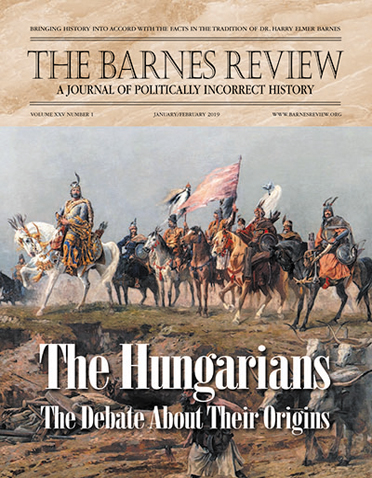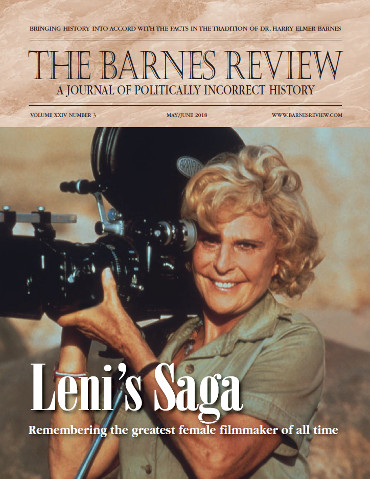
The Barnes Review, January/February 2019
$5.00 – $10.00
The Barnes Review
A JOURNAL OF POLITICALLY INCORRECT HISTORY
JANUARY/FEBRUARY 2019 ❖ VOLUME XXV ❖ NUMBER 1
TABLE OF CONTENTS
WERE FREEMASONS RESPONSIBLE FOR ANY OAK ISLAND TREASURE?
LOST INVENTIONS OF THE ANCIENTS
A NEW THEORY REGARDING THE ORIGINS OF THE HUNGARIANS
IN DEFENSE OF THE KHAZAR THEORY: THE DEBATE OVER ASHKENAZI ROOTS
ANCIENT WHITES IN MONGOLIA
WAS THE ‘HIPPIE’ MOVEMENT OF THE 1960s RUN BY THE WAR COMPLEX?
IMMIGRATION THE NEW SLAVERY?
FAREWELL TO FAURISSON: A GREAT REVISIONIST PASSES
PERSECUTION OF GERMAN ACTIVIST MUST BE PROTESTED NOW
HITLER’S AMAZING REVOLUTION: HIS VISION FOR GERMANY
- Description
- Additional information
Description
The Barnes Review
A JOURNAL OF POLITICALLY INCORRECT HISTORY
JANUARY/FEBRUARY 2019 ❖ VOLUME XXV ❖ NUMBER 1
TABLE OF CONTENTS
WERE FREEMASONS RESPONSIBLE FOR ANY OAK ISLAND TREASURE?
BY MARC ROLAND. We here at The Barnes Review have long been interested in the mystery of Oak Island, Nova Scotia and the possibility that some kind of treasure was buried there by someone many centuries ago. Was it Templars? Pirates? The French or British military? Thanks to the efforts of modern-day treasure-hunters, we may be closer to finding an answer to the “who,” if not the “what,” of the mystery.
LOST INVENTIONS OF THE ANCIENTS
BY MARC ROLAND. Many of the inventions we take for granted today—the alarm clock, seismometer, central heating and refrigeration, for example, were not dreamed up by modern man—but by ancient people millennia ago.
A NEW THEORY REGARDING THE ORIGINS OF THE HUNGARIANS
BY JOHN TIFFANY. Why do the Hungarians speak a Finno-Ugric language—a language spoken only by a few far-flung groups quite removed from modern Hungary? One scholar has a theory.
IN DEFENSE OF THE KHAZAR THEORY: THE DEBATE OVER ASHKENAZI ROOTS
BY DR. MATTHEW RAPHAEL JOHNSON. Is there any credence to the Khazar theory of Jewish origins? Why does it matter where the Ashkenazi Jews come from? Even white nationalists are arguing about it today. If the Jews are, in fact, of Turko-Mongolic stock, are 95% of the world’s Jews non-Semites?
ANCIENT WHITES IN MONGOLIA
BY PATRICK CHOUINARD. Mongolia might just be the last place on Earth you’d think of looking for the presence of an ancient white culture. But recent finds in that region indicate Mongolia is where we should be searching for our ancestors.
WAS THE ‘HIPPIE’ MOVEMENT OF THE 1960s RUN BY THE WAR COMPLEX?
BY JOHN WEAR, J.D. A movement allegedly based on peace and love, the hippie/flower child crusade of the 1960s was loaded with the offspring of parents in the U.S. military-industrial complex. Here’s the strange tale of Laurel Canyon, California and the frightening happenings there.
IMMIGRATION THE NEW SLAVERY?
BY DR. EDWARD DeVRIES. At first, you had to have been a slave owner to have your statue taken down. Soon it was anyone in the Confederacy—even an anonymous symbol like Silent Sam of North Carolina. Then it was Christian proselytizers like Fr. Junipero Serra, who allegedly mistreated American Indians. Today, however, the list has grown to anyone resisting mass immigration.
FAREWELL TO FAURISSON: A GREAT REVISIONIST PASSES
BY RONALD L. RAY. Recently Revisionism lost one of its greatest heroes, Dr. Robert Faurisson of France, who passed away in October. In this issue, TBR remembers the heroic scholar.
PERSECUTION OF GERMAN ACTIVIST MUST BE PROTESTED NOW
BY RONALD L. RAY. The insanity and maliciousness of the global Thought Police amazes even us. Ailing from terrible health and unending incarceration, freedom activist Horst Mahler is, according to reports, near death. But we can help this brave man if we all do our part.
HITLER’S AMAZING REVOLUTION: HIS VISION FOR GERMANY
BY GREGG MARCHESE. Those ignorant about the WWII era think Adolf Hitler was single-mindedly infatuated with murdering every Jew he could get his hands on. But, according to one author, dealing with the Jews was low on Hitler’s “to-do list.”
From The Barnes Review, January/February 2019:
Personal From the Editor
WE CAN ALL HAVE A HAPPY 2019
It’s the small victories that keep us going here at THE BARNES REVIEW. No doubt that the past several years have been tough, with the attacks on our ability to sell products through major online vendors like Amazon and having our payment options sabotaged multiple times. It’s hard enough for the subsidized mainstream magazine publishers to survive in these times without all those additional roadblocks, but for a small publisher like TBR, struggling every year to make ends meet, it’s even tougher.
That all being said, 2018 was a pretty good year for TBR, with prospects for 2019 looking even brighter. One of the small victories we are reveling in was making it to Volume XXV. That little miracle means we have now done what many magazines, large and small, have failed to do: Mark a full quarter-century of publishing. (For those who were there when TBR’s first issue rolled off the press, you know this is actually our 26th year of publishing, as Volume I included three issues in 1994 and all of 1995.)
So those two “XXs” and one “V” on the front cover mean a lot to us and are a tribute to those who blazed this path, some of whom were not so fortunate as to witness this milestone being passed.
But mostly it should mean something to our loyal readers who continue to renew subscriptions, send gift subscriptions, buy books and donate the extra money we need to keep TBR at the high-quality readers have come to expect. This is, in many respects, your magazine, as it is you who do all those things plus read it and try to pass on some of the knowledge contained inside to others. The saddest thing one could think of would be to have a publication that nobody ever reads. But I can tell you, from the thousands of letters I have received, you read every single word in every single issue.
So here’s a New Year’s toast to you and to the possibility of an even brighter 2019—for you and for TBR—and to another year of bringing history into accord with the facts via these pages.
A GOOD START TO THE NEW YEAR
Just as we are getting ready to go to press in late December, we have been given a precious gift. President Trump has announced—out of the blue and against the advice of the war hawks surrounding him—that he will be bringing the troops home from Syria and Afghanistan as soon as possible. At nearly the same time, the Senate voted to order the president to rescind all U.S. military assistance to Saudi Arabia related to Yemen.
For those of you who despise war as much as we do here at TBR, it’s a special gift for the families of servicemen who worry every day whether or not their loved one is going to return from wars the U.S. government should not even have them involved in. Pulling as many U.S. troops from foreign soil as possible and bringing them home—leaving other nations to handle their own internal problems—is the best and only sane foreign policy the U.S. government should pursue in the new year. It is one that TBR’s founder Willis A. Carto (and George Washington, as well) consistently espoused in word and deed.
It’s time for Uncle Sam to bring the rest of our military men home, extend an olive branch to those nations willing to live in peace with America, stop the hawkish rhetoric and end the killing. ~PAUL ANGEL, Executive Editor.
Additional information
| TBR Back Issue | PDF Copy, Print Copy |
|---|







